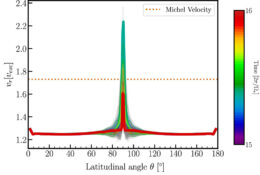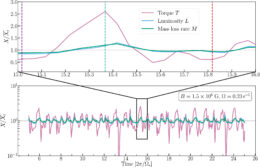In astronomy, sometimes 1 + 1 = 1. That’s the case when white dwarfs collide, creating a single massive remnant that sheds mass through powerful magnetic winds.
When Stellar Remnants Collide
Nearly all of the stars in the Milky Way, including the Sun, are fated to become white dwarfs. These Earth-sized objects are the super-hot crystallized cores of stars that have lost their outer layers after ballooning into red giants. When two white dwarfs collide, the collision can trigger a supernova, create a neutron star — an object even denser than a white dwarf — or merge the two white dwarfs into one.
In a recent research article, Yici Zhong (University of Tokyo) and collaborators modeled the properties of post-merger white dwarfs, focusing on their fast-moving magnetized winds. The results may be applicable to an unusual class of supernovae that are faint, fade quickly, and fail to fully explode — leaving behind a white dwarf remnant.
Magnetic Outflows

Radial velocity of the white dwarf’s wind as a function of latitude. The wind is fastest near the star’s equator. [Adapted from Zhong et al. 2024]
Zhong’s team found that the wind doesn’t emerge from the entire surface of the star equally and is instead fastest and most luminous near the star’s equator. Nor does the wind blow steadily: some of the gas launched from the star’s surface gets trapped in the magnetic field, and a periodic rearranging of the magnetic field ejects bubbles of this trapped gas.
The Winds of WD J005311
These findings may give researchers new ways to study a recently discovered white dwarf called WD J005311, which appears to be the remnant of a collision of white dwarfs that triggered a supernova. Unlike most supernovae caused by colliding white dwarfs, the explosion didn’t destroy the stars completely, and the surviving star’s 16,000-kilometer-per-second winds pummel the supernova remnant from within.

Modeled torque, luminosity, and mass-loss rate of the wind over time. Click to enlarge. [Zhong et al. 2024]
The team’s model also predicts that the star’s wind blows outward 20–40% faster at its equator than its poles, and this asymmetry could be detected through optical spectroscopy. The uneven speed means that the wind exerts more pressure on the surrounding nebula along its equator, possibly creating an uneven shock that could be seen in future X-ray observations.
Citation
“The Optically Thick Rotating Magnetic Wind from a Massive White Dwarf Merger Product. II. Axisymmetric Magnetohydrodynamic Simulations,” Yici Zhong et al 2024 ApJ 963 26. doi:10.3847/1538-4357/ad1f5c

